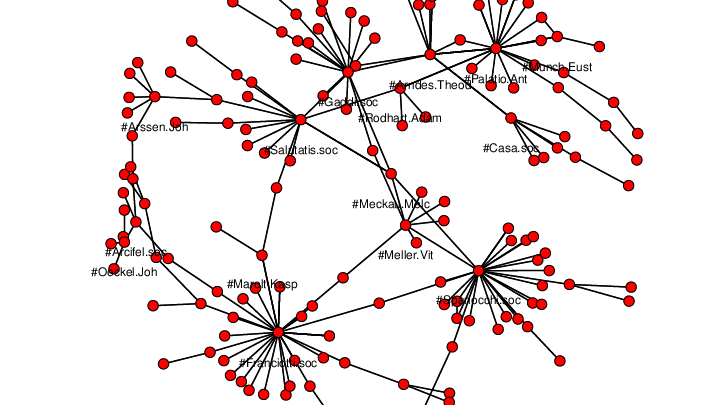
Published:
Annates payments and sources of the study
Another subject of our investigations of the RG are late medieval annates, which are also recorded in the papal chancery registers. For each prebend, fees had to be paid to the Camera Apostolica, the so-called annates, which made an important contribution to the financial stability of the Roman Curia. The fees were based on the amount of the expected income of a prebend and amounted to half a year's income, which had to be paid either personally or through third parties to the Curia in Rome.
The focus of the study was on those banks and persons who were involved in this financial transaction. The Repertorium Germanicum provides sources up to the year 1484, which were collected and handed down in the form of registers. The aim of the computer-assisted analysis was to create a network model of curial payment transactions in the pontificate of Sixtus IV. (1471-1484).
Methods and evaluations
A parser was used to filter the data using key terms (such as per manus, which identifies the payer of the fees in Rome). The data can be filtered in a straightforward way because the uniform entries about the annata payments simplify an automatic readout of the information. The extracted data were stored in a database and can be output, for example, in a CSV file that records, among other things, the document number, the date of the financial transaction, and the names of the annata debtor. In total, 500 individual entries on annata payments by German clerics in Rome between 1471 and 1484 were extracted using this method from the tenth volume of the RG, which was awarded in TUSTEP.
In the process, random samples showed that this did not at all make it possible to find all the evidence for annata payments in RG X, and that the extracted data still contained several errors. This was mainly due to variations in the original source by the writers of the Vatican records and inconsistencies in the TUSTEP markings by the editors of the edition. Based on these data a network model was developed in a pilot study, in which the actual money depositors at the Curia are linked to their German clients.
In the network shown, the actors involved represent the nodes, while the edges are the connections between these persons, the annuity payments themselves. These were made by a payer, i.e., a bank or even a private person, for the principal. Through network analysis, several stellar structures (stars) can be identified, although these individual stars were isolated from one another. The Franciotti and Spanocchi banks are particularly prominent, each of which was associated with over 20 clients. In addition to the banks, there were also several private individuals, who made deposits for a larger number of ecclesiastical clients - for example, the curial Heinrich Schönleben, who was a depositor at least ten times.
At least as much attention deserves another phenomenon, which can be derived from the visualization of the network. The phenomenon of the connections between the stars, the so-called bridges. Bridges are created where a cleric used different persons or banking houses for his payments. Persons who establish a connection between different star structures are called "brokers" in network analysis, and they play an important role in networks because they establish connections between otherwise unconnected groups.
Using mathematical network analysis, this broker position can be expressed primarily in the measure of betweenness centrality. The following table shows the betweenness centrality of the most important players:
Particularly noteworthy are the two curials Melchior von Meckau and, to a lesser extent, Vitus Meller, both of whom have a very high betweenness centrality. Melchior von Meckau ranks fourth in the ranking of all actors, only slightly behind the "professional" financial actors of the salutati, Franciotti and Spanocchi. Thus, he has a higher centrality than a few other banks. This comes mainly from the fact that he had his annuities paid by three different banks (Spanocchi, Gaddi and Salutati) as well as by Vitus Meller. Vitus Meller otherwise acted several times as a payer of annuities for third parties, and in addition once used another cleric and once the Spanocchi bank for his own annuity payments. This initially very abstract network-analytical finding generates the historical hypothesis that Meckau and Meller were important figures in the curial payment transactions of Sixtus IV's time.
Outlook and benefits of the study
This pilot study is very small in scale and preliminary but can serve as a proof of concept. The technology used, data extraction from structured texts, solves a dilemma. Frequently, data-driven research in historical studies - such as social network analysis in this case - affected the often very uncertain cost-benefit ratio of such studies so far. The collection of historical network data has been predominantly manual, and the associated high effort was sometimes in questionable proportion to the expected knowledge benefit. Well-structured data, that can be transferred into network models, in an automated or semi-automated manner (e.g.), offers decisive advantages here in terms of research economy.
Referenzen
Robert Gramsch-Stehfest: Von der Metapher zur Methode. Netzwerkanalyse als Instrument zur Erforschung vormoderner Gesellschaft. In: Zeitschrift für Historische Forschung 47 (2020), S. 1-39.